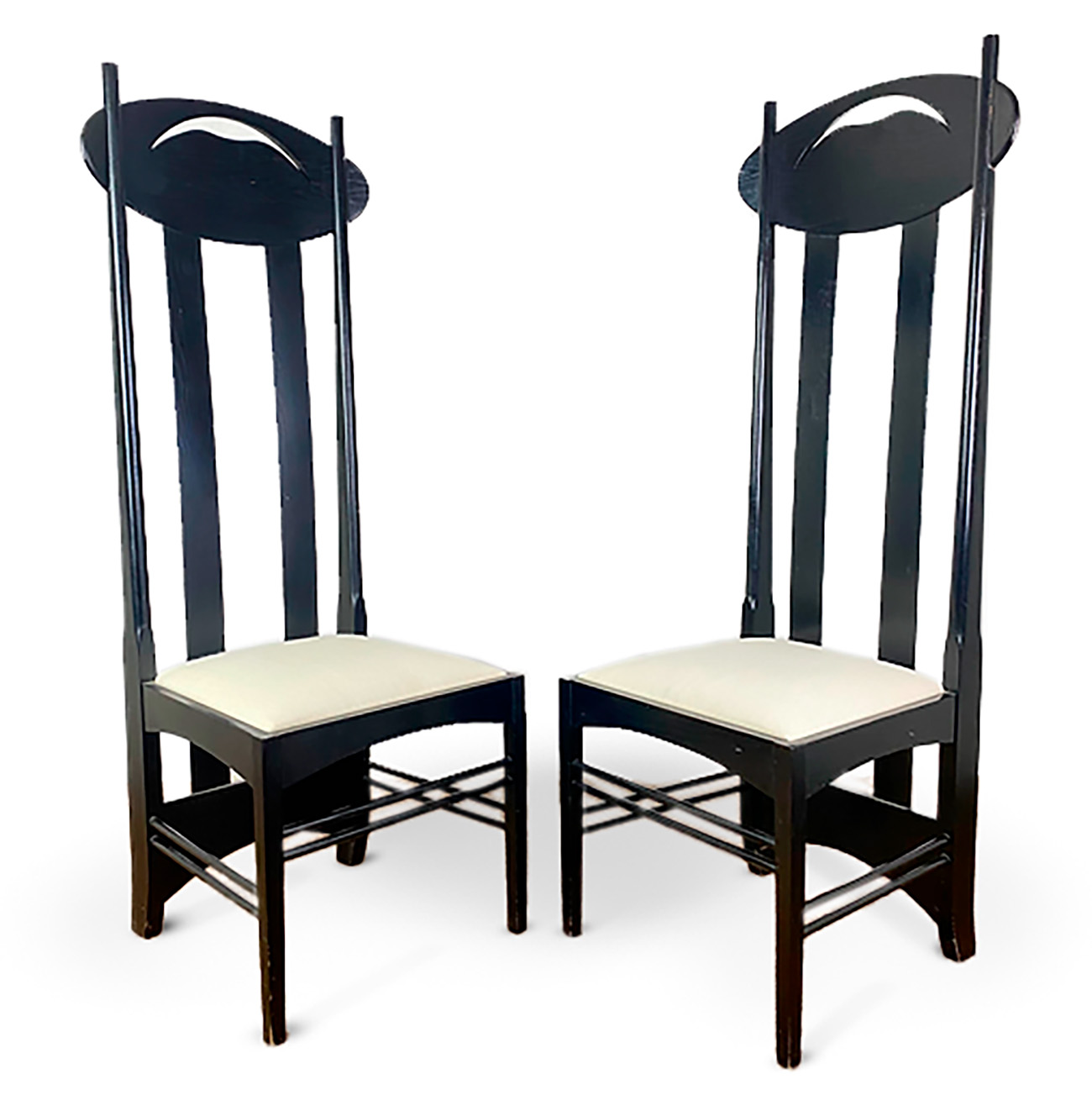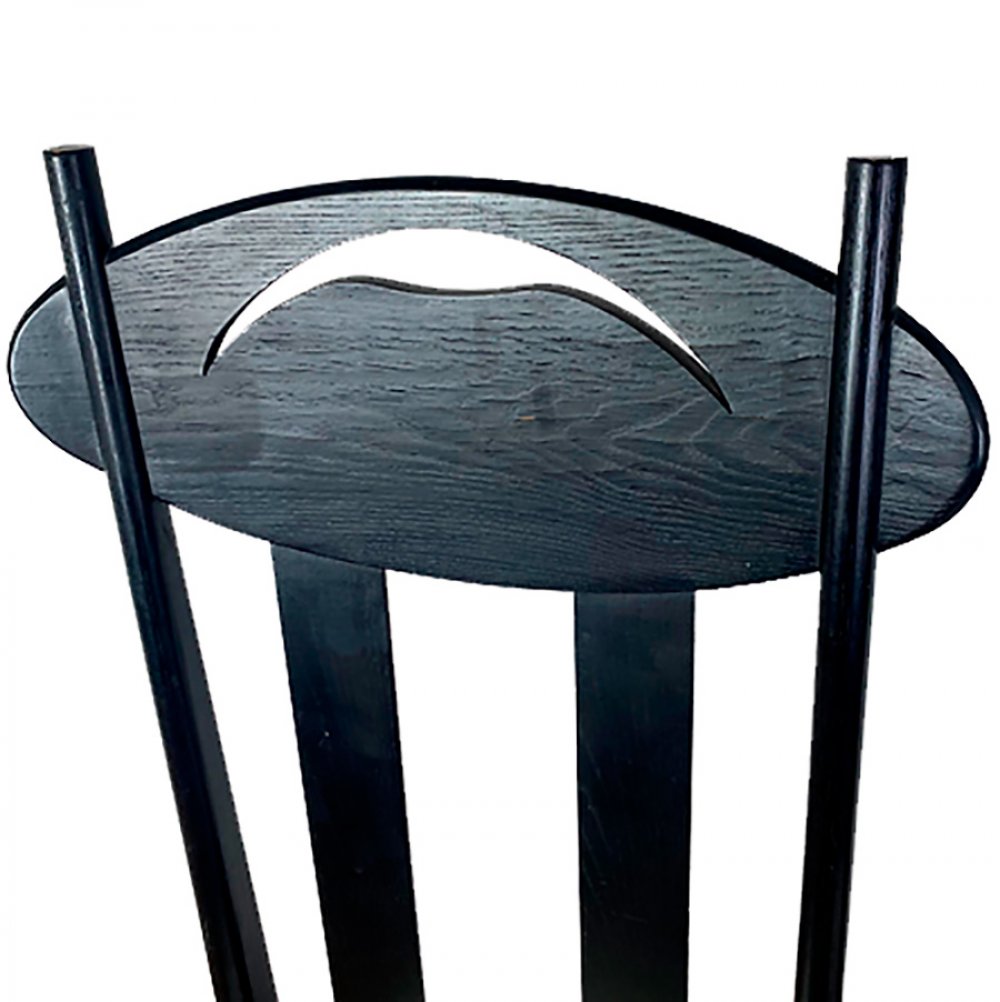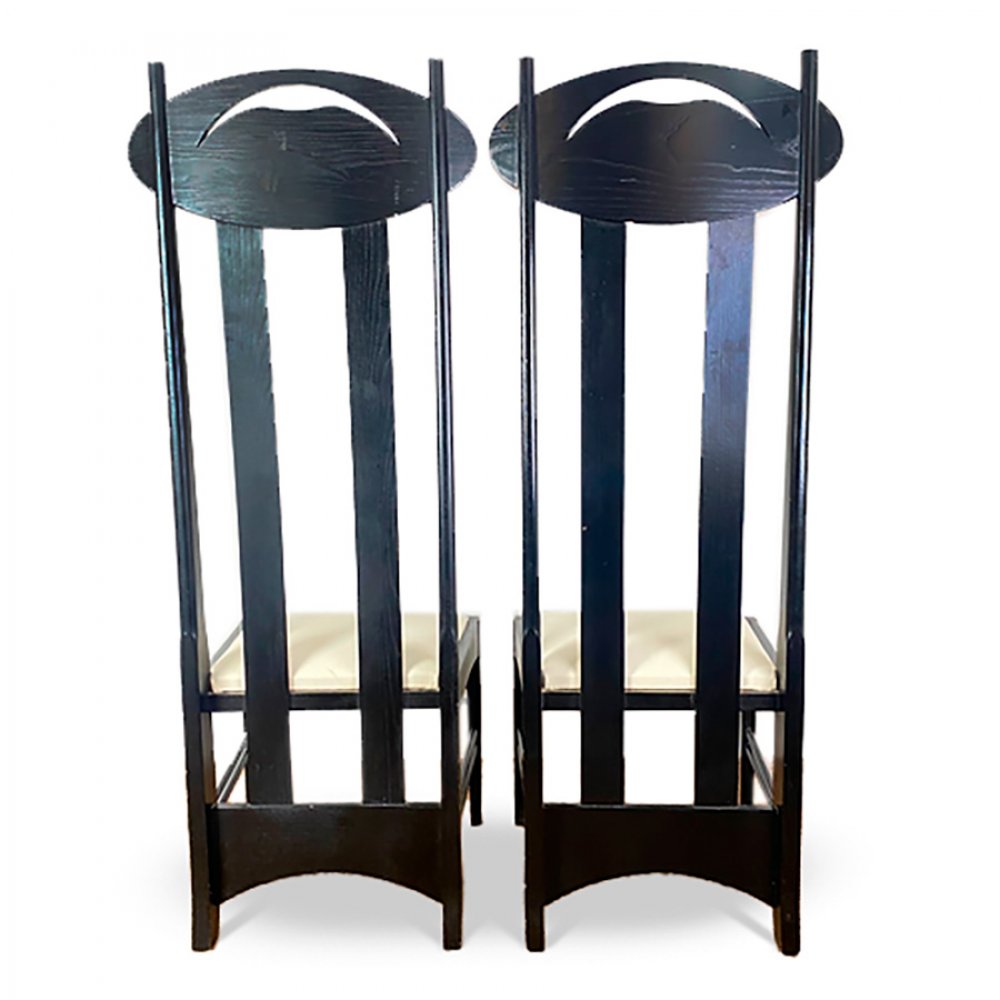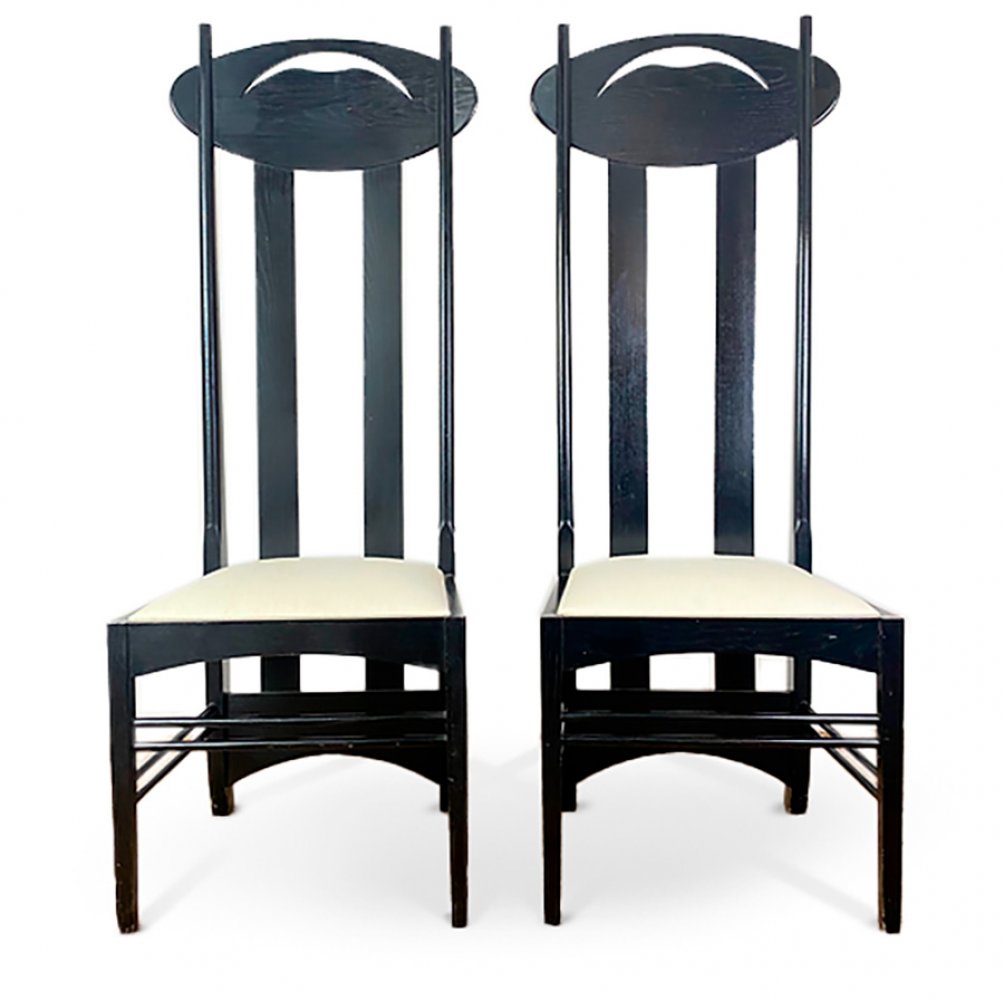15
CHARLES RENNIE MACKINTOSH (Glasgow, 1868-London, 1928) for ALIVAR.Pair of "Argyle" chairs, late
Pair of "Argyle" chairs, late 1970s.
It shows slight wear and tear due to use and the passage of time.
Measurements: 48 x 48 x 136 cm.
This is a high-backed chair created for the Argyle Street tearooms in Glasgow, characterised by a square frame in black-stained ash, on which the designer made curvilinear cuts and placed elliptical elements reminiscent of Celtic art and taste. The chair has been reissued by Cassina since 1973. Although Mackintosh is best known for his architectural works, such as the Glasgow School of Art, Hill House and the House for an Art Lover, he also designed much of their furniture and furnishings. One of the most important figures in Mackintosh's career was Catherine Cranston, a patron who allowed him to showcase his talent as a designer and appreciated his global approach. Cranston was a Glasgow businesswoman with a passion for the arts, who had the idea of opening a series of tearooms in the city with artistic interiors.
Having already established a successful tea room in Argyle Street, she invited Mackintosh to work with architect and designer George Walton on the interior of a new premises in Buchanan Street in 1896. The following year, Mackintosh and Walton again collaborated on the design of the Argyle Street tea rooms in Cranston, with Mackintosh focusing on the furnishings. It was the first major private commission of his career and an opportunity to put into practice some of his ideas about the use of furniture to create a sense of enclosure and spatial separation within a room. One of the pieces Mackintosh designed for the project was a high-backed dining chair intended to provide a more intimate dining experience for diners.
The Argyle chair has long tapered uprights that intersect with an extended oval headrest. The stylised shape of a swallow in flight has been carved into the headrest to give it an artistic and iconic character. The chair's combination of simple, sculptural elements with an emphasis on natural forms echoed the ideas put forward by the Arts and Crafts movement, of which Mackintosh was an admirer. Its extraordinary back legs are a complex piece of joinery, with a shape that begins at the base before gradually curving and tapering to become circular at the top. The unusual height of the chairs meant that they formed a screen around the tables, creating the sensation of a room within a room. It was a technique that Mackintosh would explore and perfect in many of his later furniture designs.
In 1900, the Argyle Chair was exhibited at the 8th Vienna Secession Exhibition in Austria, where Mackintosh's work was highly regarded and greatly influenced the work of artists, architects and designers in the Wiener Werkstatte community.
Pair of "Argyle" chairs, late 1970s.
It shows slight wear and tear due to use and the passage of time.
Measurements: 48 x 48 x 136 cm.
This is a high-backed chair created for the Argyle Street tearooms in Glasgow, characterised by a square frame in black-stained ash, on which the designer made curvilinear cuts and placed elliptical elements reminiscent of Celtic art and taste. The chair has been reissued by Cassina since 1973. Although Mackintosh is best known for his architectural works, such as the Glasgow School of Art, Hill House and the House for an Art Lover, he also designed much of their furniture and furnishings. One of the most important figures in Mackintosh's career was Catherine Cranston, a patron who allowed him to showcase his talent as a designer and appreciated his global approach. Cranston was a Glasgow businesswoman with a passion for the arts, who had the idea of opening a series of tearooms in the city with artistic interiors.
Having already established a successful tea room in Argyle Street, she invited Mackintosh to work with architect and designer George Walton on the interior of a new premises in Buchanan Street in 1896. The following year, Mackintosh and Walton again collaborated on the design of the Argyle Street tea rooms in Cranston, with Mackintosh focusing on the furnishings. It was the first major private commission of his career and an opportunity to put into practice some of his ideas about the use of furniture to create a sense of enclosure and spatial separation within a room. One of the pieces Mackintosh designed for the project was a high-backed dining chair intended to provide a more intimate dining experience for diners.
The Argyle chair has long tapered uprights that intersect with an extended oval headrest. The stylised shape of a swallow in flight has been carved into the headrest to give it an artistic and iconic character. The chair's combination of simple, sculptural elements with an emphasis on natural forms echoed the ideas put forward by the Arts and Crafts movement, of which Mackintosh was an admirer. Its extraordinary back legs are a complex piece of joinery, with a shape that begins at the base before gradually curving and tapering to become circular at the top. The unusual height of the chairs meant that they formed a screen around the tables, creating the sensation of a room within a room. It was a technique that Mackintosh would explore and perfect in many of his later furniture designs.
In 1900, the Argyle Chair was exhibited at the 8th Vienna Secession Exhibition in Austria, where Mackintosh's work was highly regarded and greatly influenced the work of artists, architects and designers in the Wiener Werkstatte community.
18th October - Design
Sale Date(s)
Venue Address
General delivery information available from the auctioneer
Setdart offers Worldwide shipping
PICK UP IN ROOM: You can come and pick up your lots in our offices (Barcelona, Madrid or Valencia). At the moment of the withdrawal, you will be able to accept the current conditions of the lot by means of a document that you will sign.
YOU CAN SEND ANOTHER PERSON TO PICK UP: This person must present a signed authorization that you can find in our web page by accessing from BUY AT SETDART- LOGISTICS-DOWNLOAD AUTHORIZATION DOCUMENT. You can also send an e-mail with the requested data in AUTHORIZATION DOCUMENT to admin@setdart.com
Important Information
25% buyer´s premium
21% buyer´s premium at www.setdart.com
Terms & Conditions
The maximum period to pay the lots is 7 working days. You can pay either via bank transfer or with credit card through our platform www.setdart.com (we only accept VISA or Mastercard).
BUYER´S PREMIUM: 22% Hammer price + 21% VAT from the buyer´s premium
If your piece has more than 100 years, our Ministry of Culture requires an export certificate in order for the piece to leave the country. Note that if the piece goes inside the EU, there is no cost for the export certificate. If the piece goes outside the EU, there is a cost for the export certificate. You can find more information in our Ministry of Culture website: https://www.culturaydeporte.gob.es/en/cultura/patrimonio/exportacionimportacion/exportacion/tasas.html
INQUIRIES: admin@setdart.com
Setdart guides you through the entire process, from the time of award to the day you receive your lot. Our logistics team will be happy to manage your transport, and will advise you on the best shipping method with professionals from the sector used to handling works of art and jewelry.
WE OFFER WORLDWIDE DOOR TO DOOR SHIPPING
PICK UP IN ROOM: You can come and pick up your lots in our offices. At the moment of the withdrawal, you will be able to accept the current conditions of the lot by means of a document that you will sign.
YOU CAN SEND ANOTHER PERSON TO PICK UP: This person must present a signed authorization that you can find in our web page by accessing from BUY AT SETDART-LOGISTICS-DOWNLOAD AUTHORIZATION DOCUMENT. You can also send an e-mail with the requested data in AUTHORIZATION DOCUMENT to admin@setdart.com
SETDART IS NOT RESPONSIBLE FOR THE STATE OF THE PARTS ONCE THEY LEAVE OUR FACILITIES. MRW SHIPMENTS: Once the payment is made, your lot will be packed for shipment, the logistics department will send you an e-mail notifying you of the day it leaves our warehouse, changes of address cannot be made after receiving this e-mail.
INSURANCE INCIDENTS: Coverage for the value of the auction up to 3000 ? per shipment, if the value of the auction is higher, Setdart will send you a quote including the additional insurance. The insurance company WILL NOT BE RESPONSIBLE FOR THE SHIPMENT THAT EXCEEDS THAT AMOUNT AND IS NOT FULLY INSURED. MRW INCIDENTS: Maximum notification 48 hours after receipt, after which the insurance company WILL NOT BE RESPONSIBLE AND NO CLAIMS WILL BE ACCEPTED.
E-MAIL LOGISTICS: logistica@setdart.com
PICK UP YOUR MESSAGES: You can send your own messaging, prior notice via e-mail that your shipment is ready, please note 3 or 4 days in advance. This type of shipment is packaged so Setdart will provide you with a quote.
EXPENSES FOR STORAGE: We inform you that if the purchased lot is not picked up within a month, you will be charged 30€ per week per lot. Setdart Online S.L., owner of the web site "setdart.com", "setdart.net" and "setdart.org", acts as a company of Spanish nationality inscribed in the Volume 36955, sheet 182, page B-293056 of the Mercantile Registry, with registered office at Calle Aragó















